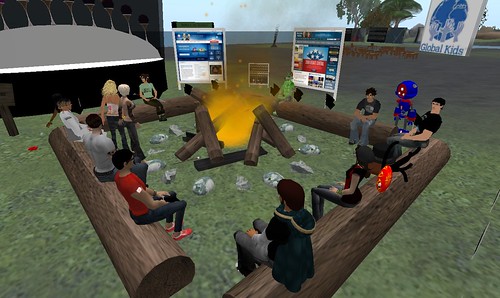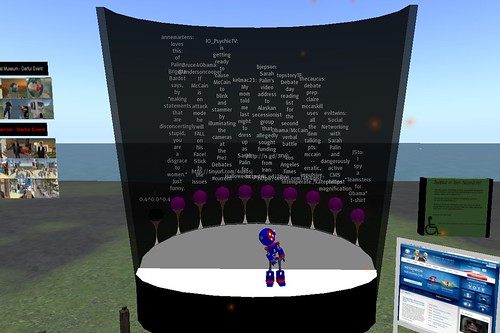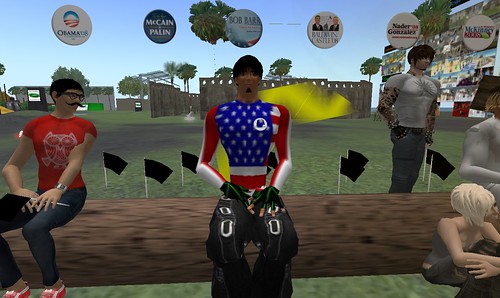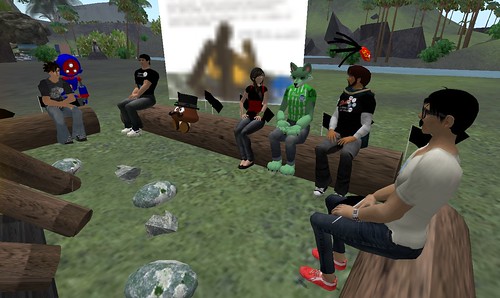Tonight I organized, with the help of my colleagues Rafi and Joyce, a presidential debate watching party in Teen Second Life. We had a very good turnout of about 28 teens, several of whom stayed for the entire 90 minutes — which is asking a lot of a teenager on a school night. Pretty much every single one of them was an Obama supporter, which should come as no surprise from my previous post on the subject. Still we had a good discussion and debate on the issues that I think helped them to think more broadly about the political process in America.
Overall it gave me hope about virtual worlds being the public sphere in a digital age.
We used the fireside chat area of of Global Kids island, which is a great informal space to have these kinds of discussions. It’s hard to be too stressed and uptight sitting around a campfire! One of our interns Mat helped decorate the space by putting up a bunch of American flags and buttons for each of the six sets of candidates on the ticket.
We wanted to make sure that the teens had access to as much useful information as possible during the event. One of our biggest coups was getting the Capitol Hill folks to let us bring over to the Teen Grid their awesome Tweet Theater that displays the ten most recent tweets about a particular candidate. Joyce did a nice job re-building the theater in the Teen Grid, even adding a bit more flair to it. Thanks to Kiwini Oe and Kei Moana from SL Capitol Hill for helping us out!
The kids really enjoyed watching the real time stream of commentary about Obama and McCain scrolling behind them as we chatted.
We also set up an audio stream of the debates from an NPR affiliate that provided an MP3 stream that we could link to. Sadly, we were not able to bring in a video feed. But we did provide several links to other websites that provided webstreams. I watched the debates over Hulu.com, which had excellent resolution and no hiccups at all.
We also provided links to the respective websites of John McCain and Barack Obama, as well as links to sites with more information comparing their positions on the various issues, including CNN, MySpace, and American Public Media’s excellent candidate comparison quiz.
The teens were fairly bored during the economy and health care portion of the debate. But they perked right up once the candidates starting talking foreign policy. Several of them were interested in Darfur and human rights. A couple were concerned about college tuition costs.
All in all, I thought this was an effective way of getting teenagers to be more engaged with the political process. I think they felt more comfortable being in a setting with a bunch of their peers rather than in a roomful of adults. Several of them seemed genuinely concerned about certain issues and got to express that to each other over the text chat. And they got to have fun, often at the expense of one of the candidates, but that’s to be expected.
I’d love to compare this to a real world gathering of a bunch of teenagers to see if we would get similar outcomes. One advantage of Second Life is that the teens can be both listening / watching the debates while also engaging in text chat with each other about what the candidates are saying. That would be really hard to do in a real life setting. And they can dip in and dip out of the event for as long as they have available, instead of travelling to some real world venue and potentially having to commit to a 90 minute event. Plus there is less risk in expressing our views in this semi-anonymous space, versus in real life where the performance anxiety associated with speaking out your views is much greater.
At the end of the evening, the teens seemed quite keen on doing this again for the last debate. We’ll see if we can organize something for what may be the decisive event of the entire election.
NOTE: You can read a more in-depth report on this event, with quotes from the teens over at Holymeatballs.org.



